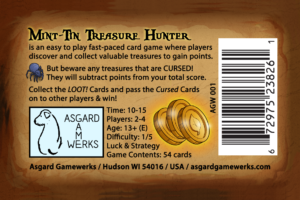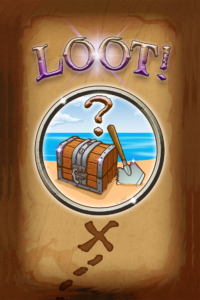Start Your Own Indie Tabletop Game Business: Part Two
In part one of Start Your Own Indie Tabletop Game Business I covered some basic topics of game ideas, game design, game development, and whether to self publish or find a publisher. I took you through my own simple process of how I went about doing things as I worked on my first game; Mint Tin Treasure Hunter.
If you found this blog post first but want to read part one prior to part two, then click here.
The intent of these blog posts is to relate my thought processes on how I have done things so far. As I write this, the second entry to Start your Own Indie Tabletop Game Business, I have one game completed and ready for manufacturing. Distribution of some sort is soon to follow. My indie company, Asgard Gamewerks, has 2-3 additional games in various phases of development that can be followed here.
Start A Tabletop Gaming Business, Part Two
Below are the reaming bullet points that were not covered in part one that I will delve into in this blog post or the next.
- Time To Think About The Business Entity
- Game Mechanic Tweaks & More Testing
- Finding Art For Your Tabletop Game
- Graphic Design Of Your Tabletop Game
- Prototyping Your Game
- More Testing
- Manufacturing
- Distribution
We left off in part one with my having decided to self publish my own games. It was at that point where I needed to come up with a business name and form a company entity of some kind.
A Business Entity For My Indie Game Company
I have some experience with LLCs, employees, paying business taxes, employee taxes, payroll, etc… Because I was not planning on hiring any employees, was planning to work from my home office, and only contracting freelancers short term, I knew I didn’t have a need for an official company formation, be it an LLC, C corp, S corp… whatever. I could operate as a sole proprietor and manage the paying of any taxes on my annual personal income taxes.
Disclaimer: Your own personal needs for starting a business can vary depending where you live and circumstance. Each State is different. Be sure to check your local laws and regulations. What worked for me may not work for what you need in order to be compliant with local and State laws where you live.
Even as a sole proprietor it was important to have a business identity. My wife and I came up with the name Asgard Gamewerks together, in honor of our pet dog. But I wanted to make that name official so I registered Asgard Gamewerks as a Tradename or Does Business As (DBA) with the State of Wisconsin.
For you the reader, at a minimum, you may need to register a tradename or DBA for your business. Check your local laws. Also, depending on the size of your indie tabletop company (employees, taxes, income) you may need to form a corporation. Again, check your local laws and even consult with a tax accountant. Better safe than sorry!
Additional Steps To Claiming A Tabletop Business Entity
Because I planned to self publish I knew I was going to be designing my own game boxes and packaging. I was also going to be placing my company logo proudly on anything I created. At this point I wasn’t sure if I was going to mass market and distribute or create product and sell through print on demand like through The Game Crafter. Either way there were a few more steps I wanted to take to claiming a business entity for Asgard Gamewerks.
- Own a domain name for Asgard Gamewerks (you’re on the website, so you know I did that!)
- Register Asgard Gamewerks with the Hobby Manufacturer’s Association (stock manufacturer code)
Hobby Manufacturer’s Association & A stock Manufacturer Code

My SMC code, “AGW” left of the UPC. 001 denotes the game SKU in my company’s product line.
Since I planned to self publish and possibly someday sell retail in game and hobby stores through Consolidators and Distributors, I wanted to make sure I had a Stock Manufacturer Code (SMC). An SMC is a 3-character prefix registered with the Hobby Manufacturers Association to prefix your product SKUs. It is optional, but is highly recommended as it makes it easier for retailers to order your product based on a code and not on a long product name.
I registered Asgard Gamewerks with the code AGM. My first game has the SMC code AGM 001 on it above the UPC code. Having each one of your games its very own company SKU is a pretty basic step in establishing your company’s game catalog.
For registering a tradename, SMC code, and a domain name for my indie game business I paid out of pocket around $50.
Social Media Footprint
The last thing I needed to do to create a business entity was to support the growth of my business name. That meant getting my indie tabletop game company name out there on social media.
I was working on a few games and wanted people to know who I was and what I was doing. It was a logical step to create social media profiles for Asgard Gamewerks. As of right now Asgard Gamerwerks can be find on Twitter, Facebook, Instagram, and YouTube. Links for finding me on those sites are located around this website. Or just go search on those platforms for Asgard Gamewerks by name.
I am looking to the future to perhaps crowdfund a game or two on Kickstarter. Working on a social media following early is always a good idea when planning a successful crowdfunding project.
Game Mechanic Tweaks & More Play Testing
After taking a day or two solidifying my business name I was back to focusing my efforts on game development processes. Mint Tin Treasure Hunter was looking solid. Its placeholder art and mechanics play tested well but it still needed a few adjustment.
After a little fine tuning I had the game back out for outside play testing.
Outside play testing means that I was not involved in the play testing. I loaned the mock-up of the game to friends, family, and also to strangers to test play at local gaming stores.
Unbiased play testing is very important. While some feedback can be simple trolling, most of it is beneficial. So pay attention to what people tell you about your game.
Within the game designer and development community you will see and hear over and over again that you need to have your game play tested. Play test your games often and by people you don’t know. Unfortunately play testing can be hard to setup and arrange.
One source I can recommend for finding play testers is to look into joining the Indie Game Alliance. As a member (starts around $10 per month) you can get your games play tested in their play test network for free. However, they usually require you to have live working copies of your game, that you of course need to make/supply.
Finding Art For Your Tabletop Game
This is the part of the development and publishing process where you start to spend money. If you are an artist that can design and draw your own art then you are fortunate to have that skill. Otherwise getting art made or purchasing pre-made art with full licensing rights can get expensive.
The more art your game needs, the more expensive it will cost. If your game has cards they will need art. And if each card is unique and needs it’s own art then things will add up fast.
You get what you pay for. Card art as an example can start anywhere from $20 to $60 per card.
Here is a list of some common items in a game that may need art:
- Playing cards, $20-$60 per card.
- Game board art, $100 to $1000.
- Box or card deck box cover art, $100 to $1000
- Token art, $5 to $60
- Unique game pieces, $5 to $60
- and the list can go on and on… ??? $$$
There are places you can go to find artists if you are not skilled in that way or don’t have a family member or friend that can help you out. If you do have a family or friend that can help you out, do you pay them and if so what?
One again the Indie Game Alliance has resources that can help you find artists that freelance themselves out for such work. But you can also check buying pre-made art on websites like Shutterstock. You can also hire freelance artists on sites like Upwork, Fiverr, Freelancer, Art Station, and others.
Negotiate And Set Deadlines
If you end up hiring a freelance artists I strongly suggest you are 100% crystal clear on what kind of art you need. You also need to talk about expected deadlines for getting art completed. And always negotiate the price and make sure you and your freelancer are in 100% agreement on EVERYTHING.
If you are not 100% clear on what you need and when you need it, hiring a freelancer can go very bad. Usually you pay half of the negotiated price up front, and the rest upon delivery. Be clear and concise on what you need, or your could find yourself having paid out for art you don’t want to use.
Graphic Design Of Your Tabletop Game

My graphic designer took the treasure chest art and created layers, with text, fades, and more to design this card back for Mint Tin Treasure Hunter.
Here is another hefty cost to getting your game made; the graphic design. Along with having art for your game you will need to have a graphic designer take that art and create layouts. Layouts for your cards, game box front, game box back, sides, game logo, and more.
Artists create art, graphic designers take that art and ad borders, text overlays, and more. Graphic design is the visual communication of your game, and very important.
Many indie game publishers try to take on this aspect themselves. If you are so inclined there is free software out there called GIMP that is actually quiet powerful and can be utilized for such work. However, if you are a novice at this sort of thing you have a steep learning curve to overcome. I wish you luck in that.
Again you get what you pay for. Graphic design freelancers can range in costs from $15 per hour to $100 per hour and beyond. Sometimes you can hire on a freelance graphic designer for a project fee instead of an hourly fee. They will also sometime be willing to work for a reduced fee in exchange for a percentage of the game’s retail royalties.
You can find graphic designers online at the Indie Game Alliance, Upwork, and Fiver.
Your Indie Tabletop Game Company, Part Two Conclusion
Part Two of starting your own indie tabletop game business has gotten long. Part three will touch base on the remaining bullet point listed above – and will be coming soon!
TD